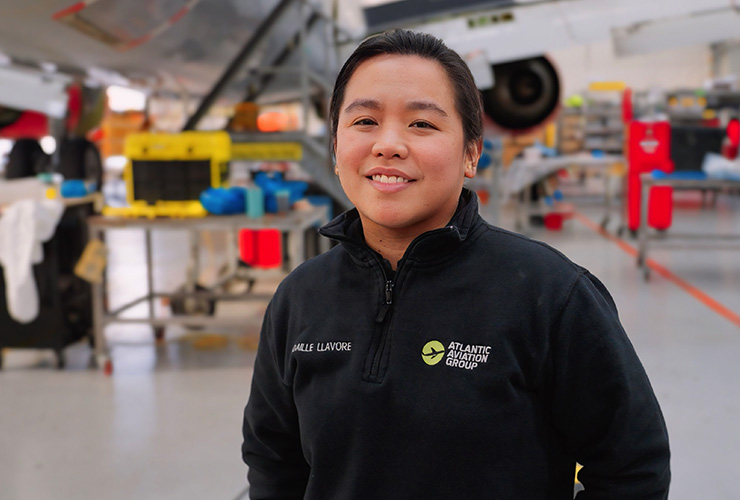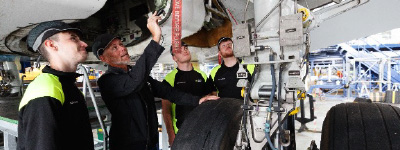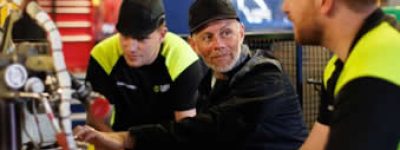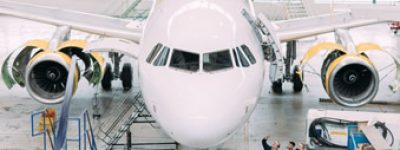FAQs & RESOURCES

Welcome to the Atlantic Aviation Group Training Academy FAQ Section. Here you’ll find answers to the most common questions about our training programmes, courses and services.
Whether you’re considering enrolling in our academy or are already a participant, this section is designed to provide you with all the information you need. From course details and enrollment procedures to certification and career opportunities, our comprehensive FAQs will guide you through every aspect of your learning journey with us. If you need further assistance, please contact our support team.
FAQs - General Information
-
What is the Atlantic Aviation Group Training Academy? +
Atlantic Aviation Group Training Academy is a premier institution offering a range of aviation maintenance and technical training Programmes, including EASA Basic Training, EASA Type Training, EASA Part 145 Mandatory Continuation Training and Consultancy.
-
Where is the training academy located? +
The academy is located in Shannon, Ireland, with examination centres also available in Dublin and at customer facilities.
-
How long has the academy been in operation? +
We have over 34 years of experience in the Aviation Maintenance Training Industry.
FAQs - Training Programmes
-
What types of EASA basic training programmes do you offer? +
We offer EASA Part 66 Basic Training for the following EASA Part 66 Licenses:
- Cat A1
- B1
- B2
- B2L
-
What types of EASA Type + Practical Training programmes do you offer? +
We Offer:
- B767
- B757
- B737NG
- B737Max
- B737CL
- B777
- A320 (Practical only)
-
What other training courses do you offer? +
We offer EASA Part 145 Continuation Training, and various specialised courses including Electrical Hand Skills, Composite Repair Training, and more.
-
What is the EASA Part 66 Basic Training Programme? +
This Programme includes Approved Cat A / B1 / B2 License courses with a “Zero to Hero” pathway, offering comprehensive training and On-the-Job Experience (OJE) in our Part 145 organisation.
-
Do you offer any degree Programmes? +
Yes, we offer a Bachelor of Science degree in Aircraft Maintenance Engineering in conjunction with Technological University of the Shannon (TUS).
-
What aircraft types are covered in the Aircraft Type Practical Training? +
Our Aircraft Type Practical Training covers B737NG, B737CL, B757, B767, B777, and A320 aircraft.
FAQs - Specialised Courses
-
What specialised courses do you offer? +
We offer a variety of specialised courses including:
- Bridging the gap: Aviation essentials for supporting and professional roles
- Electrical Hand-Skills Courses
- Aircraft Structures Technician Course
- Landing Gear Technician course
- EASA Air Legislation Courses.
- Introduction to the A320CEO with NEO Differences
- Introduction to the B737NG with Max Differences
-
What is Bridging the gap: Aviation essentials for supporting and professional roles? +
This course is designed for non-technical staff, working in the aviation industry to gain a fundamental understanding of aircraft systems and operations. This course can be made bespoke to a company as well.
-
How long is Bridging the gap: Aviation essentials for supporting and professional roles +
2 days including a hangar visit.
-
Do you provide online training? +
Yes, we offer Online training for Type and for some of our Specialised Courses.
FAQs - EASA Part 145 Training
-
What does your EASA Part 145 Continuation Training include? +
Our continuation training includes Human Factors Initial and Refresher Training, Fuel Tank Safety (CDCCL Phase 1+2), and Electrical Wiring Interconnection System (EWIS) Target Group Training.
-
Where can I take the EASA Part 66 exams? +
Exams can be taken at our approved examination centre in Shannon, Ireland.
FAQs - Aviation Training Consultancy
-
Do you offer consultancy services? +
Yes, we provide consultancy services with expertise in EASA Part 145/Part 147 and Part 66 compliance, helping clients set up operations and design bespoke training solutions.
-
How can your consultancy services help my organisation? +
Our team can provide the skills, knowledge, and guidance necessary for setting up operations, designing custom training programmes, and ensuring compliance with EASA regulations.
FAQs - Enrolment and Contact Information
-
How can I enroll in a course? +
For our Cat A1 traineeships in Dublin and Shannon you can apply on www.fetchcourses.ie »
For more information, you can also contact our admissions team. Email: 147training@atlanticaviation.ie
-
How can I get more information about the courses offered? +
You can view detailed information about our courses on our website or contact us directly via email for personalised assistance.
Email: 147training@atlanticaviation.ie
-
Who can I contact for more details or specific inquiries? +
For more details or specific inquiries, please contact our Academy Business Development team through the contact information provided on our website.
Email: 147training@atlanticaviation.ie
FAQs - EASA License Requirements
-
What is a Cat A1 License and what are the requirements to attain it? +
A Cat A1 License allows the holder to certify minor scheduled line maintenance and simple defect rectification within the scope of tasks authorised by the approved maintenance organisation.
Requirements include:
- Completion of an EASA Part 66 Cat A1 approved course.
- At least 1 year of practical maintenance experience if completed through a training course, or 3 years of practical experience if not.
- Passing the required examinations for Cat A1 modules.
-
What are the requirements for obtaining a B1.1 License? +
A B1.1 License allows the holder to certify work on aircraft structures, powerplants, mechanical and electrical systems, and to issue certificates of release to service following maintenance.
Requirements include:
- Completion of an EASA Part 66 B1.1 approved course.
- At least 2 years of practical maintenance experience if completed through a training course, or 5 years of practical experience if not.
- Passing the required examinations for B1.1 modules.
-
What are the requirements for obtaining a B2 License? +
A B2 License allows the holder to certify avionics and electrical systems maintenance on aircraft.
Requirements include:
- Completion of an EASA Part 66 B2 approved course.
- At least 2 years of practical maintenance experience if completed through a training course, or 5 years of practical experience if not.
- Passing the required examinations for B2 modules.
FAQs - Practical Experience
-
What counts as practical maintenance experience for EASA licenses? +
Practical maintenance experience includes hands-on work in an aircraft maintenance environment, performing tasks relevant to the license category you are pursuing. This experience must be documented and signed off by an authorised supervisor.
-
How can I gain the required practical experience? +
You can gain practical experience by working in an EASA Part 145 approved maintenance organisation or an equivalent maintenance facility. The Atlantic Aviation Group Training Academy offers On-the-Job Experience (OJE) opportunities as part of their training Programmes.
FAQs - Training and Examination
-
What training does the Atlantic Aviation Group Training Academy offer for these licenses? +
We offer comprehensive training Programmes for Cat A, B1.1, and B2 licenses, including theoretical knowledge, practical training, and examination preparation. Our “Zero to Hero” Programmes provide a complete pathway from no experience to fully licensed.
-
What exams are required for EASA Part 66 licenses? +
The exams for EASA Part 66 licenses cover multiple modules, each focusing on specific areas of aviation maintenance. The modules vary based on the license category (Cat A, B1.1, or B2) and include subjects such as aircraft systems, electrical fundamentals, and aviation legislation.
-
Where can I take the EASA Part 66 exams? +
Exams can be taken at our approved examination centre located in Shannon, Ireland.
FAQ's - Licensing Process
-
How do I apply for an EASA Part 66 license? +
After completing the necessary training and examinations, and acquiring the required practical experience, you can apply for an EASA Part 66 license through the national aviation authority of the EASA member state where you have completed your training.
-
Can Atlantic Aviation Group Training Academy assist with the licensing application process? +
Yes, our team can guide you through the entire process of applying for your EASA Part 66 license, ensuring you meet all the requirements and have the necessary documentation.
FAQs - Additional Support
-
Can I get further training after obtaining my initial license? +
Absolutely. We offer a range of continuation and specialist training courses to help you advance your career and stay current with industry standards.
FAQs - Understanding EASA and Related Regulations
-
What is EASA? +
EASA stands for the European Union Aviation Safety Agency. It is an agency of the European Union responsible for civil aviation safety. EASA develops common safety and environmental rules at the European level and monitors the implementation of standards through inspections in the Member States.
-
What is EASA Part 66? +
EASA Part 66 is a regulation that defines the requirements for aircraft maintenance engineer licensing. It specifies the knowledge, experience, and skills necessary to be licensed to maintain and certify the airworthiness of aircraft. The regulation covers different categories of licenses, such as Cat A, B1, and B2.
-
What is EASA Part 147? +
EASA Part 147 is a regulation that sets the standards for maintenance training organisations. Approved Part 147 organisations are authorised to provide training and conduct examinations required for obtaining and maintaining EASA Part 66 licenses. These organisations must comply with rigorous requirements to ensure high-quality training.
FAQs - Detailed Information
-
How does EASA Part 66 categorise licenses? +
EASA Part 66 categorises licenses into different categories based on the scope of work:
- Cat A: Authorises the holder to certify minor scheduled line maintenance and simple defect rectification.
- B1: Mechanical license allowing the holder to certify aircraft structures, powerplants, mechanical and electrical systems.
- B1.1: Fixed-wing aircraft with turbine engines.
- B1.2: Fixed-wing aircraft with piston engines.
- B1.3: Rotary-wing aircraft with turbine engines.
- B1.4: Rotary-wing aircraft with piston engines.
- B2: Avionics license allowing the holder to certify avionics and electrical systems.
-
What are the main responsibilities of EASA? +
EASA is responsible for ensuring aviation safety and environmental protection in Europe.
This includes:
- Developing safety regulations and standards.
- Certifying aircraft and components.
- Overseeing the implementation of regulations.
- Conducting inspections and audits.
- Providing safety recommendations and guidance.
-
What does it mean for a training organisation to be EASA Part 147 approved? +
Being EASA Part 147 approved means that the training organisation has met the stringent standards set by EASA for providing aviation maintenance training. This approval ensures that the organisation delivers high-quality training and conducts examinations that meet the regulatory requirements for EASA Part 66 licensing.
FAQs - Benefits of EASA Training and Certification
-
What are the benefits of obtaining an EASA Part 66 license? +
Obtaining an EASA Part 66 license offers several benefits:
- Recognition: The license is recognised across EASA member states and many other countries, enhancing job mobility.
- Career Opportunities: It opens up various career opportunities in the aviation maintenance industry.
- Compliance: Ensures compliance with European aviation safety regulations.
- Skill Validation: Validates the holder’s knowledge, skills, and experience in aircraft maintenance.
-
How does EASA Part 147 approval benefit students? +
Training with an EASA Part 147 approved organisation benefits students by:
- Ensuring high-quality training that meets industry standards.
- Providing structured and comprehensive courses.
- Offering recognised qualifications that enhance employability.
- Facilitating a clear pathway to obtaining EASA Part 66 licenses.
FAQs - Practical Information
-
How can I verify if a training organisation is EASA Part 147 approved? +
You can verify if a training organisation is EASA Part 147 approved by checking the EASA website or contacting the organisation directly for proof of their approval certificate or by visiting the website of the National Aviation Authority of the country where the Part 147 school is registered.
-
What is the process for EASA Part 66 examination and certification? +
The process includes:
- Completing an approved EASA Part 66 training Programme.
- Gaining the required practical maintenance experience.
- Passing the relevant module examinations.
- Submitting an application to the national aviation authority of the EASA member state where the training was completed.
FAQs - BSc in Aircraft Maintenance Engineering
-
What is the BSc in Aircraft Maintenance Engineering? +
The Bachelor of Science (BSc) in Aircraft Maintenance Engineering is a degree Programme offered in conjunction with Technological University of the Shannon (TUS). It provides comprehensive education and training in aircraft maintenance engineering, combining theoretical knowledge with practical and On the Job Experience. It is a Zero to Hero Programme.
-
What is the duration of the BSc Programme? +
The BSc in Aircraft Maintenance Engineering Programme spans 28 months, fulltime.
-
How much does the BSc Programme cost? +
The total cost of the BSc Programme is €29,000, broken down as follows:
- Year 1: €12,500
- Year 2: €12,500
- Year 3: €4,000
-
What is included in the Programme Fees? +
The following is included in your fees.
- Each student is provided with a laptop.
- All programme training material.
- Examination Fees
- Personal protective equipment (PPE)
- Tools and equipment required for the programme.
- TUS University registration fees
- Access to all the services & facilities at the TUS University campus in Limerick
-
What is not included in the programme fees? +
The following is not included in the programme fees.
- Accommodation
- Yearly Immigration Student permit fees (€300 approx. per year)
- Medical Insurance
It is advisable to contact the admissions office for a detailed breakdown of any additional expenses not covered by your fees.
-
Where is the programme delivered? +
At our Academy in Shannon, Ireland.
-
What is included in the BSc Programme Curriculum? +
The curriculum of the BSc in Aircraft Maintenance Engineering includes:
Stage 1
- Cat B1 Module 1 – Mathematics
- Cat B1 Module 2 – Physics
- Cat A Module 3 – Electrical Fundamentals
- Cat A Module 5 – Digital Techniques
- Cat B1 Module 6 – Materials and Hardware
- Cat B1 Module 7 – Maintenance Practices
- Cat B1 Module 8 – Basic Aerodynamics
- Cat B1 Module 9 – Human Factors
- Cat B1 Module 10 – Aviation Legislation
- Cat A Module 11 – Aeroplane Structures and Systems
- Cat B1 Module 15 – Gas Turbine Engines
- Cat B1 Module 17 – Propeller
Stage 2
- Basic Metal Work Basic
- Sheet Metal Work
- ATA 20 M – Standard Practices Mechanical
- ATA 20 E – Standard Practices Electrical
- Fuel Tank Safety
- Manual Handling
- Inspection Techniques
- Company Procedures Fall Arrest Course
- Airbus A320 Familiarisation Course Aircraft On the Job Experience
Stage 3
- Aircraft Practical Training
- Aircraft On the Job Experience
- EASA Part 145 Continuation Training
-
What are the entry requirements for the BSc Programme? +
Entry requirements typically include a high school diploma or equivalent as a minimum, with a strong emphasis on mathematics and English. IELTs of 6 minimum. A practical subject is an advantage but not essential. Specific entry criteria may vary, so it is advisable to check with the admissions team for detailed information.
-
What career opportunities are available after completing the BSc Programme? +
Job opportunities:
- Licensed Aircraft Maintenance Engineers in aircraft base maintenance facilities.
- Licenced Aircraft Maintenance Engineers in airline line maintenance.
If you Complete the B1.1 and or the B2 licence – increase certification privileges. Add a type course.
- Tech Services
- Continued Airworthiness Management
- Aircraft Leasing
- Management
- Training
-
How is the practical training component of the BSc Programme structured? +
The practical training component includes hands-on experience in aircraft maintenance within our EASA Part 145 approved facility. Students will gain real-world skills and knowledge through structured On-the-Job Experience (OJE), supervised by experienced professionals.
-
Are there any additional costs associated with the BSc Programme? +
The tuition fees cover the costs associated with the Programme. However, students for textbooks, materials, and examination fees.
-
Can international students apply for the BSc Programme? +
Yes, international students are welcome to apply for the BSc in Aircraft Maintenance Engineering Programme. Applicants should ensure they meet the entry requirements and may need to provide proof of proficiency in English.
-
How can I apply for the BSc Programme? +
You can apply for the BSc in Aircraft Maintenance Engineering Programme through by emailing 147training@atlanticaviation.ie and request an application form and information on the course.
-
Am I a student of TUS while attending this programme? +
Yes, students are registered with TUS Midland Midwest while attending this programme.
-
What is an EASA Aircraft Maintenance Traineeship run by the LCETB? +
The EASA Aircraft Maintenance Traineeship, run by the Limerick and Clare Education and Training Board (LCETB), is a specialised training programme designed to equip trainees with the skills and knowledge required for a career in aircraft maintenance. This traineeship is aligned with EASA regulations and combines both theoretical and practical training elements.
-
What are the key features of the EASA Aircraft Maintenance Traineeship? +
Key features of the traineeship include:
- EASA-Aligned Training: The programme is designed to meet the standards and requirements set by the European Union Aviation Safety Agency (EASA) to allow successful learners apply for an EASA cat A1 License on course completion.
- Delivered by a highly respected and qualified Part 147 School: The AAG training academy has over 34 years’ experience working with the LCETB in delivering this programme.
- Combination of Theory and Practice: Trainees receive comprehensive theoretical instruction complemented by hands-on practical training in workshops and On the job experience in a live aircraft maintenance facility.
- Industry Collaboration: The programme is developed in collaboration with industry partners to ensure that the training is relevant and up to date with current industry practices and needs.
- Duration: The duration of the traineeship typically spans 27 months.
-
What are the benefits of enrolling in the EASA Aircraft Maintenance Traineeship with LCETB? +
Benefits include:
- High-Quality Training: Access to high-quality training that adheres to EASA standards, ensuring that graduates are well-prepared for careers in aircraft maintenance.
- Practical Experience: Significant hands-on experience in a real-world maintenance environment, enhancing employability.
- Certification: Upon successful completion, trainees receive certification that will allow them to pursue their EASA Part 66 licenses.
- Career Opportunities: Increased job prospects in the aviation industry due to the rigorous and industry-relevant training provided.
-
What are the entry requirements for the EASA Aircraft Maintenance Traineeship? +
Entry requirements typically include:
- Educational Background: have a Leaving certificate or equivalent, with a H5 or O4 in mathematics and English. IELTs of 5.5 min required for non-native English speakers.
- Interest in Aviation: An interest in aviation and aircraft maintenance.
- Other Requirements: Specific requirements may vary, so it is advisable to check with the LCETB for detailed entry criteria.
-
How can I apply for the EASA Aircraft Maintenance Traineeship run by LCETB? +
Interested candidates can apply through www.fetchcourses.ie »
-
Can I transition from a Cat A1 license to higher certifications after completing the 2-year trainee programme? +
Yes, after obtaining a Cat A1 license and gaining additional experience, you can pursue further training and examinations to qualify for higher certifications such as Cat B1 or B2.
Online Resources
- Personnel Licensing (iaa.ie) »
- Federal Aviation Administration (faa.gov) »
- EASA | European Union Aviation Safety Agency (europa.eu) »
- Easy Access Rules | EASA (europa.eu) »
- Home – FET Course Hub (fetchcourses.ie) »
- Quality and Qualifications Ireland (qqi.ie) »
- Recognition of foreign qualifications | Quality and Qualifications Ireland (qqi.ie) »
- Home – TUS »
- Aircraft Maintenance Engineering – BSc – TUS »
- Student Handbook – TUS »
- Study in Ireland – Education in Ireland »
- Home – Immigration Service Delivery (irishimmigration.ie) »
- IASA – Irish Aviation Students’ Association »
- EAMTC – European Aviation Maintenance Training Committee »
- Aviation Skillnet | Skillnet Ireland »
- Skills to Advance | Solas | Learning Works »
- Home | Moodle.org »
- gov – Aviation (www.gov.ie) »
- Bridging the Gap – Aviation Essentials for Supporting and Professional Roles Brochure 2025
Start Your Career
Embark on an exciting journey with Atlantic Aviation Group, where your career can take flight.
Our training programmes are designed to equip you with the skills and knowledge needed to excel in the aviation industry. Choose from our award winning 4 Year Apprenticeship or 2 Year Traineeship.




